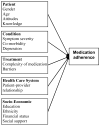Predictors of medication adherence using a multidimensional adherence model in patients with heart failure
- PMID: 18722327
- PMCID: PMC2603618
- DOI: 10.1016/j.cardfail.2008.02.011
Predictors of medication adherence using a multidimensional adherence model in patients with heart failure
Abstract
Background: Medication adherence in heart failure (HF) is a crucial but poorly understood phenomenon. The purpose of this study was to explore factors contributing to medication adherence in patients with HF by using the World Health Organization's multidimensional adherence model.
Methods and results: Patients (N = 134) with HF (70% were male, aged 61 +/- 12 years, 61% with New York Heart Association III/IV) were studied to determine the predictors of medication adherence derived from the multidimensional adherence model. Medication adherence was measured objectively using the medication event monitoring system for 3 months. Three indicators of adherence were assessed by the medication event monitoring system: 1) dose-count, the percentage of prescribed doses taken; 2) dose-days, the percentage of days the correct number of doses were taken; and 3) dose-time, the percentage of doses that were taken on schedule. Barriers to medication adherence, ethnicity, and perceived social support predicted dose-count (P < .001). New York Heart Association functional class, barriers to medication adherence, financial status, and perceived social support predicted dose-day (P < .001). Barriers to medication adherence and financial status predicted dose-time (P = .005).
Conclusion: A number of modifiable factors predicted medication adherence in patients with HF, providing specific targets for intervention.
Figures


References
-
- Stanley M, Prasun M. Heart failure in older adults: Keys to successful management. AACN Clin Issues. 2002;13:94–102. - PubMed
-
- Cleland JG, Clark A. Has the survival of the heart failure population changed? Lessons from trials Am J Cardiol. 1999;83:112D–119D. - PubMed
-
- De Geest S. Another perspective in understanding adherence: qualitative research in unraveling the behavioral dimension of heart failure management. J Cardiopulm Rehabil. 2005;25:164–165. - PubMed
-
- Rich MW, Gray DB, Beckham V, Wittenberg C, Luther P. Effect of a multidisciplinary intervention on medication compliance in elderly patients with congestive heart failure. Am J Med. 1996;101:270–276. - PubMed
-
- Col N, Fanale JE, Kronholm P. The role of medication noncompliance and adverse drug reactions in hospitalizations of the elderly. Arch Intern Med. 1990;150:841–845. - PubMed
Publication types
MeSH terms
Substances
Grants and funding
LinkOut - more resources
Full Text Sources
Other Literature Sources
Medical
Research Materials
Miscellaneous

